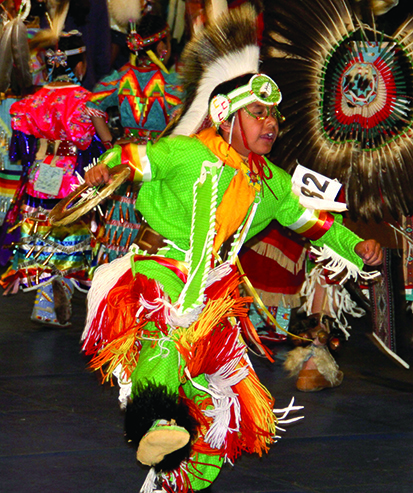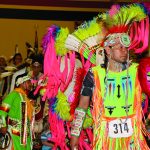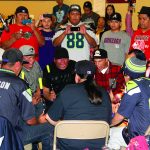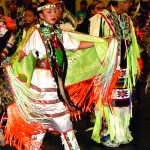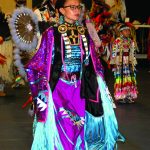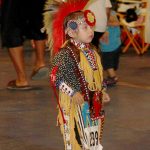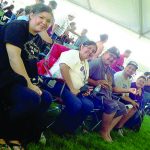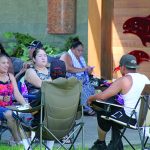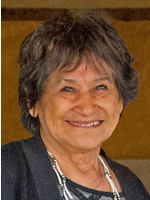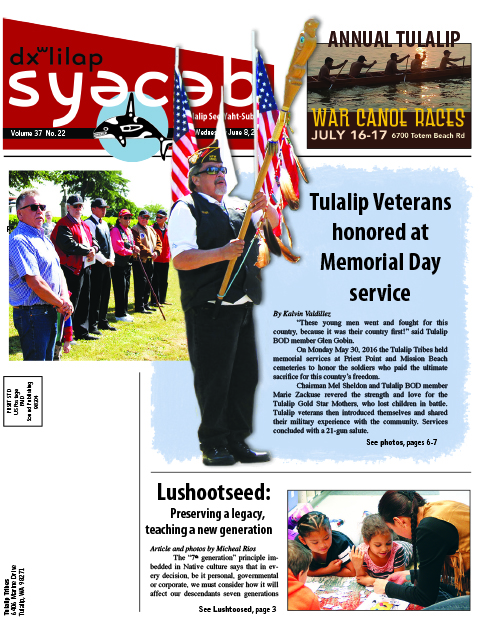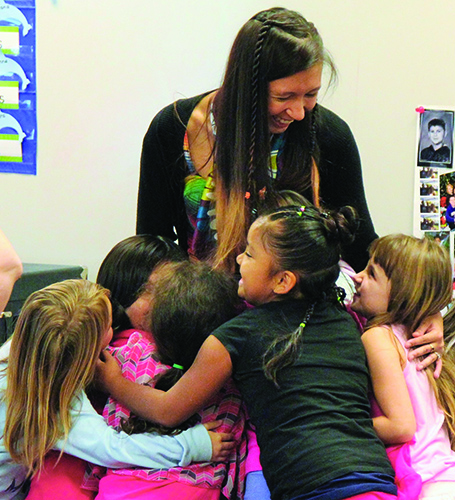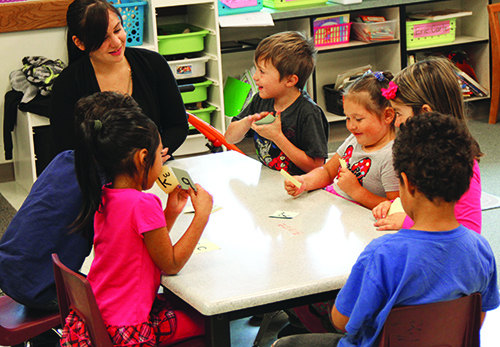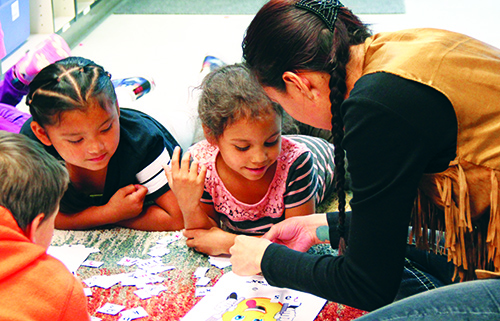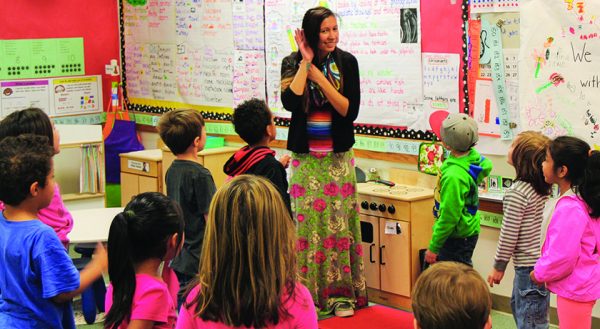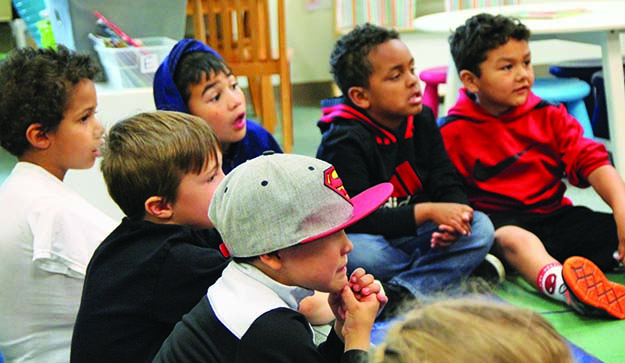Officers won’t be charged in death of Tulalip man during incident
By Scott North, The Herald
TULALIP — The Sept. 18 death of a Tulalip man during a late-night struggle with law officers was a tragic accident and not a crime, Snohomish County Prosecuting Attorney Mark Roe has determined.
Cecil D. Lacy Jr., 50, was a member of the Tulalip Tribes who had worked as a commercial fisherman. He collapsed and died in the 6400 block of Marine Drive. An autopsy determined he suffered a heart attack while struggling with two Tulalip Tribal Police officers and a Snohomish County sheriff’s deputy.
The officers’ actions that night were legally justified and they will face no criminal charges, Roe said in a Thursday letter.
“Cecil Lacy Jr. was a well-known member of the Tulalip Tribes, with many people who loved him. His death was ruled an accident, and in my opinion, that’s exactly what it was,” Roe wrote to two members of the Snohomish County Multiple Agency Response Team.
The cadre of detectives from around the county investigates officer-involved deaths.
The SMART investigation determined the officers were attempting to help Lacy the night he died.
Motorists called 911 to report a man walking in the darkened roadway that winds through the heart of the reservation. The responding officers found Lacy in an apparent state of intoxication, Roe wrote.
Lacy was told that he wasn’t under arrest, but that police needed to make sure he got out of the road and made it home safe. They offered to take him there in a patrol car, but on the condition that Lacy agreed to be handcuffed, the prosecutor wrote.
Lacy initially rejected that idea, saying that he had an injured shoulder. He then suggested that his hands be cuffed in front of him. Officers agreed, Lacy was cuffed, and the interaction was recorded on the officers’ body cameras, Roe wrote
Lacy “was not confrontational. He never assaulted or appeared to be trying to hurt anyone or escape,” the prosecutor wrote. He walked to one of the patrol cars and climbed into the backseat.
“It looked like the officers had successfully defused the situation and that things were going to be fine,” he added.
Then, as the door was being closed, the situation turned.
Lacy reportedly pushed the door back open and climbed out of the car.
In the struggle alongside the road, officers used an electronic stun gun in an attempt to subdue Lacy.
The man collapsed and attempts to revive him were unsuccessful.
The county medical examiner, Dr. Daniel Selove, later attributed Lacy’s death to a heart attack due to methamphetamine in the man’s system, as well as several other health-related factors. Those include an enlarged heart, obesity, hypertension and mental health issues.
The medical examiner determined the stun gun played no role in Lacy’s death.
Lacy’s family released this statement Friday through their attorney, Gabriel Galanda of the Seattle law firm Galanda Broadman.
“The family continues to suspend judgment about exactly what happened on September 18, 2015,” he wrote. “But they are troubled that in the very few writings we have thus far seen, both the investigators and prosecutor completely gloss over what happened to Cecil during his ‘short’ and fatal ‘struggle’ with law enforcement.
“Their reports are void of any explanation regarding the most critical seconds and moments before Cecil passed. There is much, much more to be learned about exactly how he passed.
“With very heavy hearts, the family remains intent on discovering the true causes of their loved one’s death,” he added.
Culture-filled weekend at Tulalip
by Kalvin Valdillez, Tulalip News
The Tulalip Tribes had a busy culture-filled weekend. The Annual Veteran’s Pow Wow, held at the Don Hatch Youth Center, kicked off on Friday June 3 and lasted until late Sunday June 5.
During all three days of the event the gym was over-flowing as dancers and drum circles honored the Veterans of Native America. Boye Ladd held the title of MC for the weekend, and the Arena Director was Randy Vendiola. Outside, the weather reached a high 90 degrees which allowed event-goers a chance to step out and admire the beautiful bay, skate park, new field, and of course the many art, craft, and food vendors that came for the pow wow.
On the last day of the pow wow, as the Veterans stood up for recognition, one Vet asked the gym if anybody made their way down to the Slahal Tournament that was simultaneously happening the same weekend at the Tulalip Amphitheatre. He went on to say that he had dropped by the Stick Game event and was pleasantly surprised with the large turnout.
“It’s beautiful. All these Natives living clean and sober having fun at these drug and alcohol free events, it’s beautiful. Thank you Tulalip!” The Stick Game Tournament had a $63,000 total payout, with multiple games played throughout the weekend.
“Being Frank” Cooperation helps us survive
By Lorraine Loomis, Chair, Northwest Indian Fisheries Commission
I am glad that the treaty tribes in western Washington were finally able to reach agreement with the state on a package of conservative salmon fisheries for Puget Sound. It took more than a month of overtime negotiations to make it happen, but cooperative co-management showed us the way.
Western Washington is unique because 20 treaty Indian tribes and the state Department of Fish and Wildlife jointly manage the salmon resource and share the harvestable number of fish returning each year.
That job was a lot easier when there were more fish to go around. But salmon populations have been declining steadily for decades because their habitat is disappearing faster than it can be restored. Salmon returns the past couple of years – especially coho – have taken a sharp turn for the worse.
Some say just stop fishing and that will fix the problem. It won’t. From birth to death, habitat is the single most important aspect of a salmon’s life. As the habitat goes, so go the salmon and tribal culture and their treaty fishing rights.
For millions of years, salmon were abundant in western Washington. Their sheer numbers, naturally high productivity and good habitat provided resiliency from the effects of disease, drought and a host of other environmental factors. We must rebuild that resilience.
As salmon populations grow smaller, management becomes increasingly difficult, and the co-managers struggle to divide a steadily shrinking pie. We must make the pie bigger.
The non-stop loss of salmon habitat in western Washington must be halted so that our habitat restoration efforts can successfully increase natural salmon production. In the meantime, we need to rely on hatcheries to provide for harvest and help offset the continuing loss of habitat.
We also must build resiliency in the co-manager relationship created by the 1974 ruling in U.S. v. Washington that upheld tribal treaty-reserved rights and established the tribes as salmon co-managers.
We remember the bad old days of the late ’70s and early ’80s when the tribal and state co-manager relationship was new and mistrust ran deep. We spent a lot of time, money and energy fighting one another in federal court hearings rather than focusing together on the resource.
Things didn’t begin to change until former state Fish and Wildlife director Bill Wilkerson said enough was enough and sat down with the late NWIFC Chairman Billy Frank Jr. The result was the birth of cooperative co-management in 1984 which led to the annual development of agreed fishing plans that allowed the tribes and state to focus on managing the fish instead of fighting each other in court.
This year, for the first time in more than three decades, the tribal and state co-managers failed to reach agreement on a joint package of Puget Sound salmon fisheries within the North of Falcon process timeframe. Instead we developed separate fishing plans for consideration by NOAA Fisheries under their ESA authority.
But in the true spirit of co-management, we kept the door open to further negotiations, and it worked. We weathered the storm together and we are stronger for it.
We know our relationship will be tested again in the years to come. But this year has shown us that we can survive those challenges as long as we keep cooperation at the heart of co-management.
Othello Tiny House Village Holds Community Celebration
June 8 2016 syəcəb
Tulalip Community Wellness Project Open House, June 7
Lushootseed: Preserving a legacy, teaching a new generation
by Micheal Rios, Tulalip News
The “7th generation” principle imbedded in Native culture says that in every decision, be it personal, governmental or corporate, we must consider how it will affect our descendants seven generations into the future. Long before environmentalists got us thinking about “carbon footprints” and “sustainability”, indigenous peoples lived in balance with the world around them. But then hundreds of years of colonization happened that nearly drove our population to extinction. Yet, still we remain.
Then came the decades and decades of federal policy aimed at forced assimilation for the remaining Native population who were confined to reservations. Policy after policy required children to be removed from their homes and communities, and enrolled in boarding schools where many were punished or beaten for speaking their Native languages. As a result, generations of Native people either never learned their language or lost their fluency in it. Thus, many links to traditional culture and knowledge were broken. Still we remain.
From the ashes of the colonial fire that ravished our people, we endured even though much was lost. The language of our region, Lushootseed, once spoken by thousands of Coast Salish people in Washington State clings to life by the small number of people dedicated to preserving it. Lushootseed’s territory extends from north of present-day Mount Vernon to south of Olympia.
Recent decades have seen a cultural resurgence in Puget Sound tribal communities, including carving, weaving, canoe making, and efforts to revitalize Lushootseed. New tribal museums and long houses have been constructed, and events such as the annual Canoe Journey involve hundreds of participants and thousands of spectators.
Today, on the Tulalip reservation, few elders remain who learned Lushootseed as a first language. In fact, Lushootseed Department Manager Michelle Balagot says there may be only 30-40 tribal members who can speak Lushootseed with some degree of conversational skill. She adds that although that number is incredibly low, the department is working hard to make sure that the language survives, and the next few years will be critical if the language is to be revitalized to the point that children become and remain fluent speakers.
The biggest advancement in preserving and revitalizing Lushootseed amongst Tulalip tribal members has been building an essential staff of Lushootseed teachers whose love for their language and culture can easily permeate through the young minds and spirits of our most precious resource, our children.
This past school year the Lushootseed Department had full access to teach our ancestral language to the kindergarten classes and one 1st grade class at Quil Ceda Tulalip Elementary School. It was the return back to a curriculum that had been paused in 2011 when the old Tulalip Elementary was closed.
“We have noticed an increase in student engagement when students have the chance to learn the language that connects them to their heritage. It certainly makes education more meaningful for our students,” says Cory Taylor, Quil Ceda Tulalip Elementary Principal. “While the Lushootseed program serves many Native students, it also benefits non-Natives, too. These students have the unique opportunity to develop skills to be culturally responsive. These skills will be beneficial throughout their lives. As students learn about other cultures and languages they are more likely to honor diversity and appreciate cultural awareness.”
Lushootseed language teachers Maria Martin and Nikki St. Onge, known respectfully as Miss Maria and Ms. Nikki to their students, were selected to initiate the language revival at the elementary. They taught three classes individually and one “immersion” class jointly, for a grand total of seven classes.
For Miss Maria and Ms. Nikki, it was an opportunity to perpetuate the many Lushootseed stories and phrases they learned as children, and build upon the legacy of those who came before them.
“My year teaching at Tulalip Quil Ceda was wonderful. I didn’t get a chance to learn Lushootseed in school after I left the Montessori, so being able to go back to the school I attended as a child and teach Lushootseed is amazing,” said Miss Maria. “This means we are growing as a language department and spreading our culture in places we weren’t able to before. Growing up I had a yearning to know and learn my culture, but it wasn’t offered in the schools. For the students that are enrolled in Tulalip or surrounding tribes, Lushootseed is their language, and my hope is they’ll be filled with the same kind of pride I have to know the words of our ancestors.”
“I really enjoyed teaching at Tulalip Quil Ceda. I am very grateful to have the opportunity to work with some of my students, since they were babies when I worked at the child care center in 2011. Then again at Montessori when I first started in the Lushootseed department in 2012, and now moving up with them to kindergarten,” marvels Ms. Nikki. “Not a lot of people get the opportunity to have this experience. It’s really rewarding to watch them grow and develop their own personalities and characteristics, and also teach them such an important part of our culture.
“Growing up at my Grandma Rachel’s house, I was exposed to Lushootseed a little bit with words or phrases like: x̌ʷubiləxʷ (be quiet), gʷəƛ̕əlad (stop it, behave), spuʔ (fart/blow wind), ʔaləxʷ k̓ʷid (what time is it?), hədʔiw (come in), č̓ut̕əp̓ (flea), sp̓əc̓ (feces), sqigʷəc (deer), yəx̌ʷəlaʔ (eagle), sqʷəbayʔ (dog), and pišpiš (cat). I was always interested in learning to speak Lushootseed, but it was never offered in school. When I saw the job advertisement within the Lushootseed Department I was excited. I have always wanted to learn Lushootseed and I love working with kids, so it was a perfect opportunity for me to grow as a person and to give back to the Tribe and community.”
Both Miss Maria and Ms. Nikki having taught Lushootseed at the Tulalip Montessori meant a strong familiarity and trust with their Tulalip students in their kindergarten classes at the elementary. All of their former students remembered them and were very excited to have them as Lushootseed teachers again. The excitement was shared by both teachers as they were able to create their own curriculum and teaching plans for students they knew very well. They knew what teaching methods would work and wouldn’t work with their students already.
Throughout the school year the students learned to play games, some of their favorites being təs-təs (matching game), ɬiʔɬdahəb (fishing), stab kʷi ʔəsx̌ʷil̕ (what’s missing?), xʷiʔ gʷadsx̌ək̓ʷud (don’t turn over), ʔuc̓əlalikʷ čəd (I win/bingo), go fish, and tic-tac-know. Students completed daily work sheets that taught them how to read and write in Lushootseed while reinforcing many of the vocabulary words they learned at Montessori and the new Early Learning Academy.
Some of their favorite songs they learned are: ʔi čəxʷ syaʔyaʔ (hello friend), kʷədačiʔb čəɬ syaʔyaʔ (ring around the rosy), huyʔ syaʔyaʔ (good bye friend), ʔə tə tib, ʔulub miʔman pišpišpiš (ten little kittens), šəqild st̕ilib (respect song), sʔacus sʔilalubid (head, shoulders), baqʷuʔ stubs (Frosty the Snowman), and waq̓waq̓ st̕ilib (frog song). The students were able to hear stories that were translated into Lushootseed and traditional stories such as “tsiʔəʔ bəšč̓ad” (Lady Louse), “tsi sxʷəyuq̓ʷ” (The Basket Lady), and “Clamming with Lizzie.” They learned to count up to 25 and were exposed to 30 and 40. They have also learned verbs, farm animals, woodland animals, body parts, clothing and so much more.
As the year progressed and the Lushootseed curriculum continued to evolve, so did the students. They developed such a good working knowledge with certain phrases and words that it became common place to hear the young students speaking Lushootseed even when Miss Maria and Ms. Nikki weren’t around.
“It’s difficult to put into words because it’s such an amazing experience to witness, this ownership of language and seeing themselves reflected in their school. It feels like this belongs to them between the drumming, the dancing and morning messages, then coming into class and starting our day with Lushootseed,” stated Mrs. Poyner, Kindergarten teacher and host to the immersion class taught by both Lushootseed teachers. “Having both Miss Maria and Ms. Nikki in the class at the same time I’ve really noticed the students are picking up the language much more quickly. They are using it in other parts of the day, like when we’re teaching math they’ll start counting in Lushootseed instead of English. When we’re doing letters of the alphabet and brainstorming words that start with a specific letter they’ll come up with Lushootseed words. When we are learning new stories with animals in it they’ll call the animals by their Lushootseed name. It’s so exciting to see them apply what they’ve learned into other pieces of their day.”
The teachers are even hearing numerous stories about their students using Lushootseed at home with their parents.
“I have heard stories of the students going home and singing the songs they learned in class and using their Lushootseed words,” says Miss Maria. “Running into parents of my students and hearing that they are reinforcing their Lushootseed at home makes my heart glow.”
Ms. Nikki echoes the sentiment, “Hearing from parents and teachers that students are reinforcing Lushootseed outside of their time spent with me in classroom is probably the most rewarding feeling. It means the students are not just learning a curriculum, they are learning a language, their language.”
Being able to demonstrate what you’ve learned is the basis of knowledge, and the young students using Lushootseed when the teachers aren’t around is proof positive the internal flame to connect with our culture and ancestors through language is being rekindled. It’s all part of an essential process to carry on our ancestors’ legacy by keeping the language alive. Because seven generations from now, we want Lushootseed to be the common language of all Tulalip people, like it was for our ancestors.
Contact Micheal Rios: trios@tulaliptribes-nsn.gov
Beef Jerky Outlet Celebrates National Beef Jerky Day

Percentage of Sales from Entire Weekend to Benefit Wounded Warrior Project®
KODAK, Tenn. (May 2016) – Beef Jerky Outlet locations across the U.S. are gearing up for National Beef Jerky Day, which takes place annually on June 12. This year, the Beef Jerky Outlet is celebrating the entire weekend leading up to National Beef Jerky Day with the $25 Extravaganza and a new charity partnership with Wounded Warrior Project® (WWP).
Five percent of the purchase price on all Beef Jerky Outlet transactions from June 10 through June 12, 2016, will be donated to WWP. The partnership is a natural fit because beef jerky is the number one favorite snack of the U.S. military. Jerky is easily transportable and a long-lasting food source, making it an ideal treat for our soldiers. In fact, NASA has sent beef jerky into space with our astronauts on multiple occasions.
“Our partners understand that wounded veterans need our compassion and support as they heal from the visible and invisible wounds of war,” said Gary Corless, chief development officer at WWP. “Thanks to the generosity of partners like Beef Jerky Outlet, we’re able to continue to provide the programs and services that meet injured service members, their families, and caregivers, wherever they are on their road to recovery. Whether its access to mental or physical health treatments, employment assistance programs, or continuing education opportunities, Wounded Warrior Project’s programs and services are offered free of charge, for a lifetime.”
In addition to partnering with WWP the Beef Jerky Outlet honors active and retired military personnel by offering them a 10 percent discount on any transaction, year round. The discount jumps to 50 percent for active and retired military franchisees purchasing their first Beef Jerky Outlet location.
“The Beef Jerky Outlet is a huge supporter of the U.S. military,” says Kathy Raines, Beef Jerky Outlet COO. “We’re proud to support our nations wounded veterans, by partnering with Wounded Warrior Project.”
The Beef Jerky Outlet specializes in more than 200 premium jerky varieties and sizes. Some popular specialty meats include alligator, elk, kangaroo and venison. They also offer a variety of exotic jerky flavors such as Moonshine and Cajun.
Jerky is lean, high in protein and nutritional value, and low in calories, carbohydrates, and fat (jerky is only 3 percent fat). It truly is the perfect treat for meat lovers of all ages and the popularity is rapidly growing.
- IRI, a Chicago based market research firm, reports sales of jerky jumped 46 percent from 2009- 2015, catapulting it to a $1.24 billion industry.
- In 2015 alone, Americans spent $2.8 billion on beef jerky
- Jerky is in the beef snack category — the fastest growing segment of the snack food industry (Convenience Store Decisions, Nov. 2012).
- Register to win free jerky for a year!
- $25 for three 4-ounce bags of jerky
- $25 for a Wild Game Box
- $25 for five bags of popcorn
- Free PETA (People Eating Tasty Animals) T-shirt to the first 10 customers each day
- Launch of the BJO Loyalty Cards Program (spend $25 five times and get $10 off)
About the Beef Jerky Outlet:
The Beef Jerky Outlet was founded in 2010 and is the country’s first national jerky franchise. There are currently 57 franchise locations, including 6 founder-owned stores. Over the next 18 months, this number will grow to more than 100 locations across the US. The Beef Jerky Outlet specializes in more than 200 jerky varieties including kangaroo, alligator, venison and elk. It is available in various sizes, as well as exotic flavors ranging from Moonshine to Cajun. Today, jerky is one of the fastest growing snacks in the snack food industry. This dried, smoked meat is the number one snack of the military, including NASA, which has been sending astronauts into space with jerky since 1996. Jerky is lean, high in protein, low in calories, is very low fat and has a very long shelf life. Millions seek out and enjoy this very nutritious snack every day. IRI, a Chicago based market research firm, reports that jerky sales have turned into a $1.24-billion industry. Across the country people are literally eating it up!
About Wounded Warrior Project®:
The mission of Wounded Warrior Project® (WWP) is to honor and empower Wounded Warriors. WWP’s purpose is to raise awareness and to enlist the public’s aid for the needs of injured service members, to help injured servicemen and women aid and assist each other, and to provide unique, direct programs and services to meet their needs. WWP is a national, nonpartisan organization headquartered in Jacksonville, Florida. To get involved and learn more, visit woundedwarriorproject.org.
NACTEP – Native American Career & Technical Education Program
by Jeanne Steffener, Tulalip Tribes Higher ED
Have you heard of the Native American Career & Technical Education Program (NACTEP)? More than likely you have seen advertising in the See Yaht Sub in the past for these classes at the Tulalip College Center. NACTEP was authorized to provide grants to Indian tribes, tribal organizations and Bureau funded schools to support career and technical education programs by the Federal Government. These programs are provided to help Native Americans prepare for high-skill, high-wage or high-demand occupations in established or emerging professions. The grant provides for the program’s teachers, tuition, books and stipends for students so they can effectively participate in their education.
Tulalip Tribes has partnered with Everett Community College (EvCC) and Edmonds Community College (EdCC) to provide the Native American Career and Technical Education Program (NACTEP) courses here at Tulalip. With EvCC the focus has been on the Tribal Business Technology Certificate Program. These classes may be applied to a future degree. The goal of the courses and program is to provide students with the skills and knowledge necessary to gain employment as office support and customer service front line staff. There is a current need within the Tulalip Tribes for these skills.
Edmonds Community College’s focus has primarily been on the Leadership-Management courses. The Leadership Certificate of Completion can be earned by completing a series of courses on Supervision Basics, Presentation Skills, Leadership, Effective Teams and Coaching & Mentoring.
The success rates for NACTEP students is documented and demonstrates that Native American students are progressing through these skill and knowledge building programs nationwide. These students are better prepared to pursue further education or enter into high-skilled or high-wage employment. Courses are offered to all Tulalip members, employees & community members.
This Summer 2016 quarter is beginning July 5th. Courses offered this summer are Business Communications, Introduction to Microsoft Word, Job Search/Professional Development, Beginning Keyboarding, Keyboarding – Speed & Accuracy, Records Management, Service Essentials for Business, Computer Literacy. We are having two (2) Drop-In Sessions on May 31 (2-4 pm) & June 16 (4-6 pm) at the Administration Building in room 263. The complete AD will be in a couple of upcoming issues in the See Yaht Sub. Please look for them.
If you are interested in becoming part of this success story and opening up your opportunities, just pick up your phone and dial 360-716-4888 to contact the Higher Education Department for more information or email us at highered@tulaliptribes-nsn.gov.



